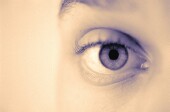New Treatment for 'Lazy Eye' Shows Promise
U.S., Chinese project finds 90% of vision gains retained 1 year after therapy.
|
E-mail this article
Subscribe to news
Printer friendly version
|

(SOURCE: University of Southern California, news release, March 3, 2008)
TUESDAY, March 4 (HealthDay News) -- A new treatment for lazy eye shows promise in adults, say American and Chinese researchers who found the therapy worked well in 20-year-old volunteers.
Lazy eye, also known as amblyopia, has been considered irreversible after age 8. Many people with the condition, especially those in developing countries, are diagnosed too late for conventional treatment with an eye patch, the researchers noted.
This new method, called perceptual learning, involves training with a simple visual task to improve vision.
A pilot trial at a Beijing hospital found that 28 of 30 patients showed dramatic gains after a 10-day course of treatment with the new method, said research group leader Zhong-Lin Lu, a University of Southern California neuroscientist.
"After training, they start to use both eyes. Some people got to 20/20. By clinical standards, they're completely normal. They're not amblyopes anymore," Lu said in a prepared statement.
The gains among the patients averaged two to three lines on a standard eye chart. Previous research found that the improvement is long-lasting, with 90 percent of vision gain retained at least one year after the therapy.
The research was described in a study published in this week's online issue of the Proceedings of the National Academy of Sciences.
Amblyopia, which can't be corrected with glasses, affects about 3 percent of people. Symptoms of the disorder include poor vision in one eye, poor depth perception, difficulty seeing three-dimensional objects, and poor motion sensitivity. Amblyopia is caused by poor transmission of images from the eye to the brain during early childhood, leading to abnormal brain development, according to background information in a new release about the research.
While this new perceptual learning therapy shows promise, it hasn't been proven to be effective in a clinical setting, noted Dennis Levi, dean of optometry at the University of California, Berkeley.
"It's clear that perceptual learning in a lab setting is effective. However, ultimately, it needs to be adopted by clinicians, and that will probably require multi-center trials," Levi said in a prepared statement.
More information
The U.S. National Eye Institute has more about amblyopia.
Copyright © 2008 ScoutNews, LLC. All rights reserved. 
HealthDayNews articles are derived from various sources and do not reflect federal policy. healthfinder.gov does not endorse opinions, products, or services that may appear in news stories. For more information on health topics in the news, visit the healthfinder.gov health library.